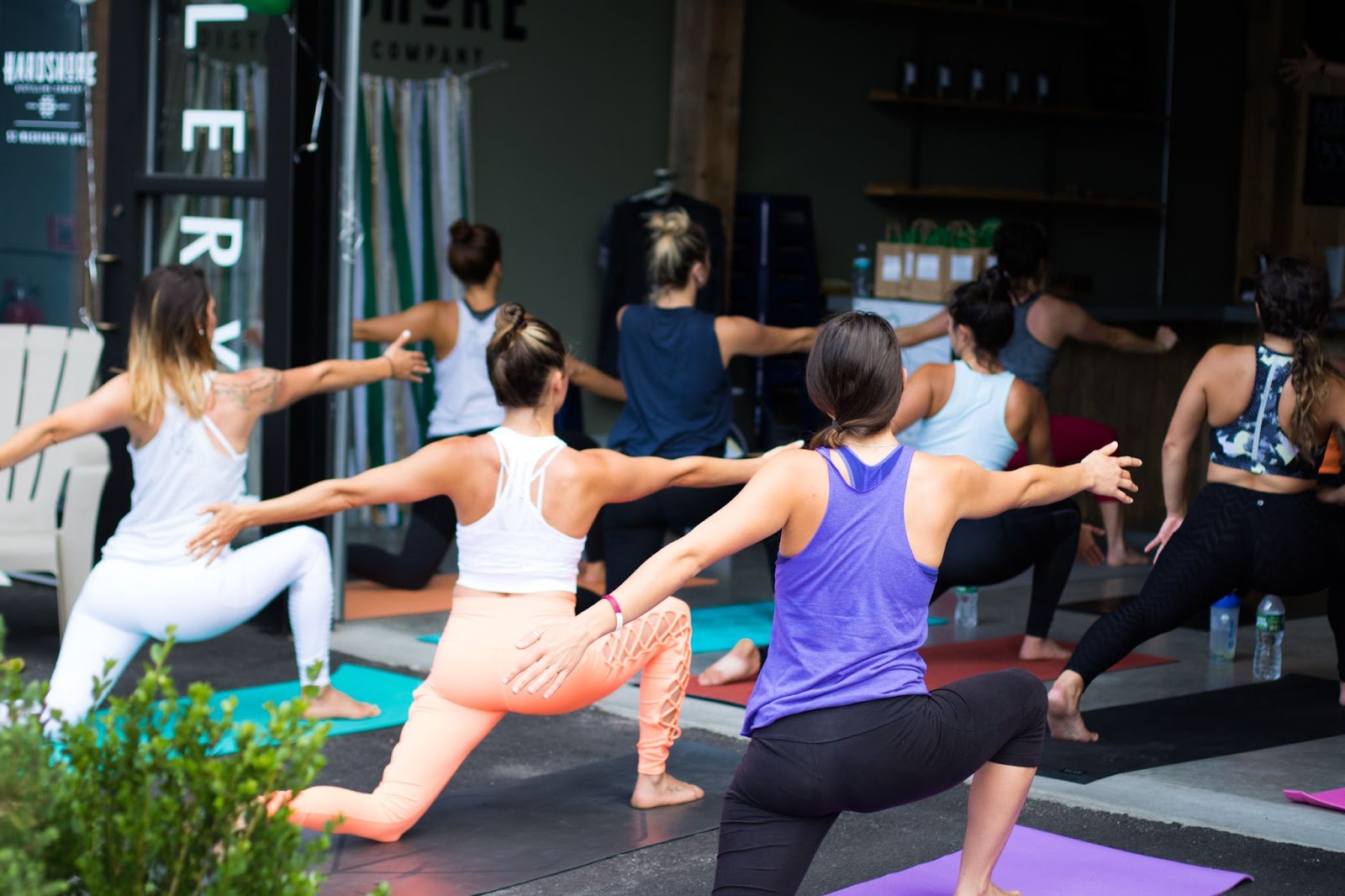On the fence about giving yoga a try? Here are several reasons that adding yoga to your workout routine can help you get stronger, reduce stress, and see better results.
I resisted trying yoga for a long time. Like, a really long time. 🙈
I had a few friends who loved it and recommended it to me, but it just didn’t feel like my thing. My goals for exercising have always been to tighten and tone my body and get stronger. Yoga didn’t seem like it would be as effective as my other workouts.
But one day I woke up really sore from a leg workout. We’re talking I had a hard time getting out of my chair after I sat down to eat lunch. Needless to say, it was a problem.
After listening to me moan and complain, one of my friends once again suggested I give yoga a try. I was pretty desperate for some relief, so I spent about 10 minutes moving through some simple yoga poses I found online.
It was amazing! I wasn’t magically cured of course, but stretching out all of those tight muscles helped loosen me up and kept me moving better the rest of the day.
From there I started regularly adding yoga to my workout routine and the results have been worth it. If you’ve been trying to decide if yoga is something you want to try, then keep reading.
This article was written by Isaac Robertson, Co-Founder and Chief Editor of Total Shape and a registered nutritionist and personal trainer. He gives you a breakdown of all the benefits of adding yoga to your workout routine and the best version to help you reach your fitness goals. 🙌

Disclosure: This site uses affiliate links. If you click on one of the links and make a purchase I may receive a small commission. This doesn’t change the price for you and helps to support this blog. To learn more about my policy, click here.
Benefits of Integrating Yoga with Other Workouts
Yoga is more than just a physical exercise; it brings in an element of mindfulness and mental toughness which is rare in other forms of workouts. It trains you to be patient and endure because remaining in a pose is challenging for both your body and mind.
Also, adding yoga can improve recovery time, and alleviate muscle soreness and fatigue in your routine. Therefore, if you are looking for a whole-mind and whole-body fitness approach, you might need to unfold your yoga mat now.
Yoga Before or After Workout?
Let’s get straight to it: adding yoga to your workout routine can be a game-changer, but when’s the best time to do it? Is it best to do yoga before or after your main workout? Both options have their unique advantages. So, let’s keep things chill and walk through the benefits of yoga before and after your workout.
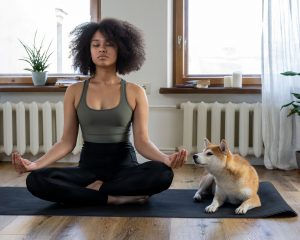
Yoga Before Workout
When you do yoga before your main workout, you are essentially warming up the body in a holistic manner. Here’s why you might want to consider it:
- Preps the Muscles: The gentle stretching in yoga can get the blood flowing, which prepares your muscles for the workout ahead.
- Enhances Focus: Beginning with yoga can help you to mentally gear up. You’re setting your mind in a ‘workout mode’, ensuring that you’re present throughout the exercise session.
- Increases Flexibility: This is particularly important if you are doing workouts that require a good range of motion, like squats or lunges.
Yoga After Workout
If you’re leaning towards ending your session with yoga, here’s what you can expect:
- Cool Down: Yoga can serve as a cool-down phase, letting your heart rate drop gradually.
- Reduces Soreness: Stretching after a workout can reduce muscle tightness and soreness.
- Mindful Relaxation: After a strenuous workout, yoga can help in calming the mind, promoting better relaxation and sleep.
[convertkit_form form=”1092723″]
Adding Yoga Into Different Training Regimes
Yoga isn’t a new kid on the block. Rooted in ancient Indian traditions, it’s been the go-to for holistic wellness for centuries. Nowadays, top athletes and their coaches aren’t just sticking to push-ups and sprints; they’re adding yoga to their workout routines. And why? Here are the reasons:
- Strength Training: When you’re hitting those weights, it’s all about power and muscle. But imagine deepening your squat or achieving a smoother deadlift. Adding yoga to your workout routine lets you stretch out those muscles, helping you sidestep stiffness and boost your lifting form.
- Cardio Workouts: There’s nothing quite like a satisfying run or bike ride. Your heart races, and you’re completely in the zone. But did you know that yoga can enhance your lung capacity? This means you can breathe deeper during those intense cardio moments.
- Team Sports: For those into team sports, like basketball or soccer, agility and coordination are crucial. Yoga emphasizes body balance. So, by integrating yoga into your routine, you can move faster, dodge with ease, and truly enjoy the game.
- Endurance Training: Marathons and long-distance cycling demand endurance. Yoga trains your mind and body to stay calm and centered. Incorporate yoga, and you’ll find yourself pushing further, without feeling as drained.
Regardless of your training style, yoga has something to offer. It’s more than just an addition; it’s a way to keep your body and mind in top shape. Give it a whirl and feel the transformation! And if you’re keen to dive deeper, watch more videos to enhance your understanding and practice.
Related posts:
- Beginner Family Yoga Routine to Try at Home {FREE Printable}
- A Quick Beginner Yoga Routine You Can Do at Home
- 60 Awesome Yoga Quotes to Inspire Your Next Practice
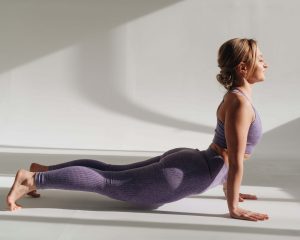
Types of Yoga for the Fitness Buffs
For fitness enthusiasts looking to diversify their routines, yoga offers a wealth of styles to fit every goal and preference. Whether you’re aiming for strength, flexibility, or mental clarity, there’s a type of yoga that’s perfect for you.
- Power Yoga:
- Details: An offshoot of Ashtanga, Power Yoga is a vigorous, fitness-based approach to the Vinyasa style.
- Example: A typical session might include a dynamic sequence of poses, often synchronizing breath with movement, and can be modified to be more or less challenging.
- Best for: Those looking for a cardio workout and to build muscle and strength.
- Ashtanga Yoga:
- Details: This is a systematic sequence of predetermined poses. It’s physically demanding and often recommended for seasoned practitioners.
- Example: The primary series involves a set of poses that you follow in the same order every time.
- Best for: Those who like routine and are looking to combine strength training with flexibility.
- Vinyasa Yoga:
- Details: Often called “flow yoga”, Vinyasa involves sequencing various postures together in a dance-like way.
- Example: You might move from a downward dog to a warrior pose and then into a triangle pose, all in one fluid motion.
- Best for: Those who dislike monotony and enjoy a variety of postures in one session.
- Hatha Yoga:
-
- Details: An umbrella term for many of the physical practices of yoga, today’s Hatha classes are often gentle and can be a good place for beginners to start.
- Example: A class might involve holding each pose for a few breaths, focusing on proper alignment and relaxation.
- Best for: Those seeking a more meditative practice, emphasizing mindfulness, relaxation, and balance.
[convertkit_form form=”1092723″]
Yoga for Recovery and Chill Days
Gym junkies, listen up! Consider using your recovery days to incorporate yoga into your workout routine. Gentle yoga forms, such as Restorative Yoga or Yin Yoga, play a key role in muscle repair, boosting flexibility, and ensuring you’re prepped and ready for your next intense training session.
Safety First
Remember, safety is paramount in all exercise forms, including yoga. Understand your body’s limitations.
There’s no rush to strike advanced poses during your first few sessions. Prepare for each practice, respect your boundaries, and if you have any health issues, consult a doctor before attempting new yoga poses.
Yoga: It’s More Than Just Poses
It’s a mind game too. The mindfulness and meditation aspect of yoga is like a balm for our stress-riddled minds, leading to a healthier, happier you. While many focus on the physical poses (asanas) of yoga, it’s crucial to remember its profound mental benefits.
Yoga teaches us to be present, discouraging us from dwelling on the past or becoming overly fixated on the future. Increased mindfulness, for instance, can bolster our emotional well-being, reducing anxiety and offering a balanced perspective on life’s challenges.
Furthermore, the deep breathing techniques (pranayama) integrated into yoga sessions not only enhance lung capacity but also act as a natural tranquilizer for the nervous system. So, with yoga, you’re not just stretching muscles, you’re also stretching your capacity for inner peace and resilience.

The Anatomy of a Yoga Pose
When adding yoga to your workout routine, it’s helpful to understand the anatomy of a pose. Each asana (or pose) targets specific muscle groups. For instance:
- Downward Dog (Adho Mukha Svanasana): This pose strengthens the arms, shoulders, and back while stretching the hamstrings, calves, and arches of your feet.
- Warrior II (Virabhadrasana II): This challenges your legs and ankles and opens your chest and shoulders.
Understanding the anatomy of each pose allows you to work on specific muscle groups and incorporate yoga effectively into your workout regime.
Busting Some Yoga Myths
- “Yoga isn’t real exercise” – Think again! With styles like Power Yoga, you’re in for a real workout.
- “I’m as flexible as a wooden board” – Everyone starts somewhere! Consistency in practice improves flexibility.
- “Yoga is only for women” – Not at all! Many ancient yogis were men, and today, countless men benefit from the practice.
- “Yoga is a religion” – While rooted in spiritual traditions, yoga is a philosophy and a practice. It does not require adhering to any specific religious beliefs.
- “You need expensive gear to practice yoga” – A simple mat and comfortable clothing are all you really need. It’s more about the practice than the paraphernalia.
- “Yoga is just about stretching” – While flexibility is one benefit, yoga also focuses on strength, balance, breathing, and mental clarity.
- “Yoga is easy” – Like any skill, it can start easy and become more challenging. Advanced postures and deep meditation require dedicated practice and can be quite demanding.
- “Yoga is only for the young” – People of all ages practice yoga, from children to seniors. Its adaptability means that there’s a style and level for everyone.
- “You should be vegetarian to practice yoga” – While some yogis choose vegetarianism for ethical and health reasons, it’s not a requirement. Yoga emphasizes individual paths and choices.
- “Yoga can’t help with mental health” – Numerous studies have shown the benefits of yoga for mental well-being, including reducing symptoms of anxiety, depression, and stress.
[convertkit_form form=”1092723″]
In Conclusion: Make Yoga Your BFF
By adding yoga to your workout routine, you’re not just getting physical benefits, but you’re also enriching your mental well-being. Dive in, dispel those myths, and let yoga be a lifelong pal in your fitness journey. Enjoy the balance and wholesomeness it brings to life!
Ready to try adding yoga to your workout routine? Let me know in the comments below or email me at Candice@littlestepsbighappy.com. Follow me on Pinterest for more fitness tips and advice.
Want more fitness tips for moms?
- 5 Powerful Reasons Exercise is Important for Moms
- How to Avoid Mom Guilt Over Exercising: 10 Quick Tips
- How to Find Time to Workout as a Busy Mom: 11 Tried & True Tips
- 7 Quick Workout Ideas for Busy Moms on the Go
- 7 Ways to Get a Quick Workout at Home
- 3 Reasons You Don’t Exercise Regularly and How to Start
- 7 Easy Ways Moms Can Live a Fitness Lifestyle
- Walking Tips for Beginners: 7 Things You Need to Know
- How to Run Better and Lose Weight: 10 Running Tips for Beginners
- 5 Benefits of Running Clubs for Your Health & Wellness Goals in 2023
- Quick & Helpful Tips for Setting up a Home Gym
- 10 Tips for Hiring a Personal Trainer You’ll Love
- 6 Easy Tips to Help You Crush Your Exercise Goals
Pin this for later!!
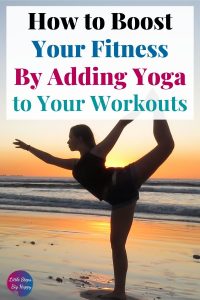
You might also like…

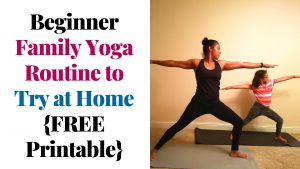


Isaac Robertson is the CEO and Co-Founder of Total Shape, a leading fitness brand focused on providing high-quality nutrition and training advice to customers around the world. As a registered nutritionist and personal trainer with over a decade of experience in the fitness industry, Isaac is passionate about helping people achieve their health and fitness goals. Under his leadership, Total Shape has become a recognized name in the industry, known for its commitment to innovation and customer satisfaction.

